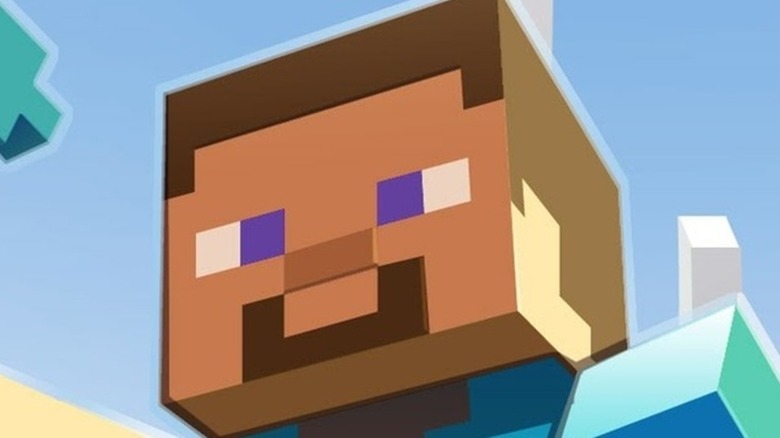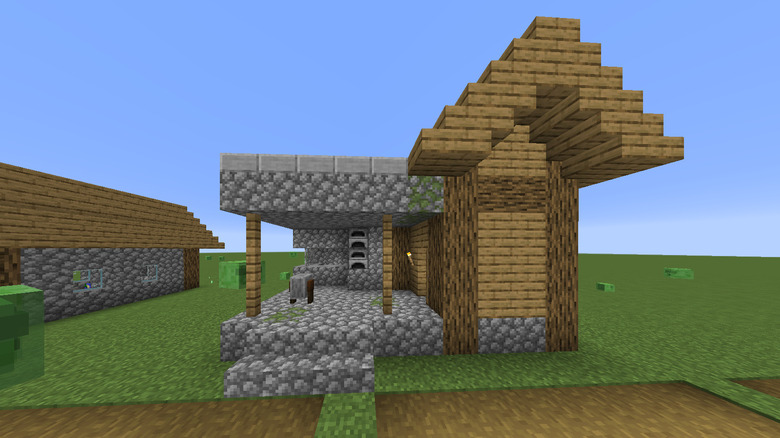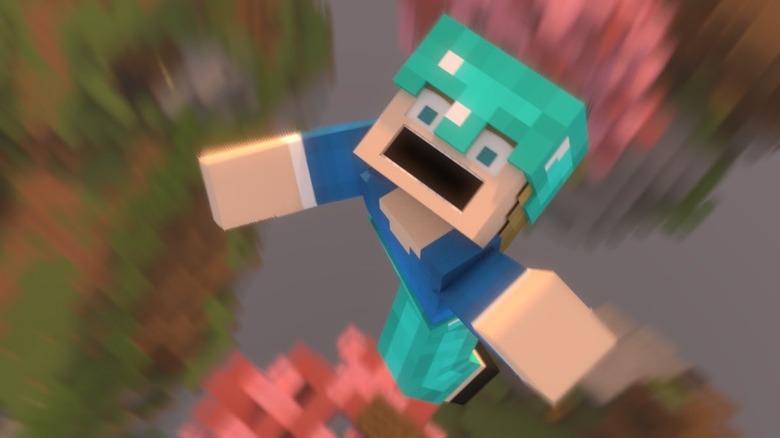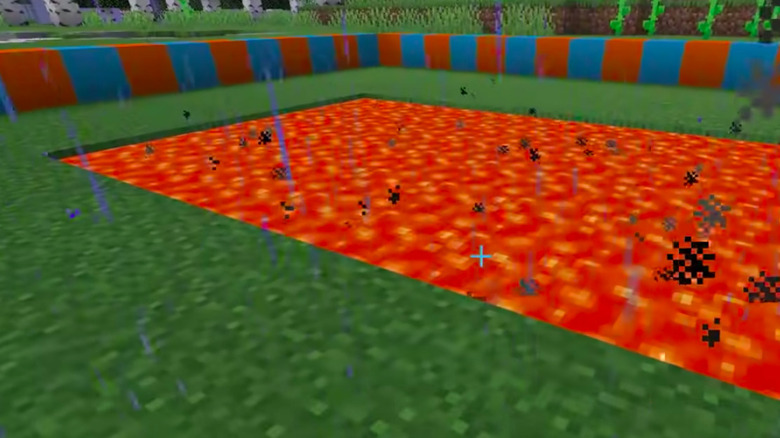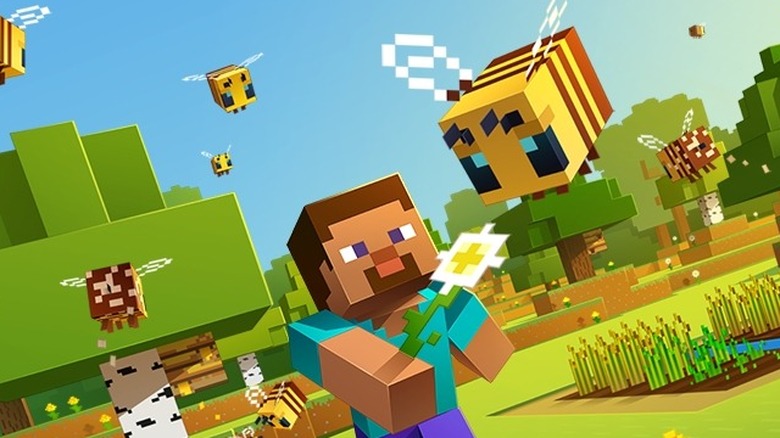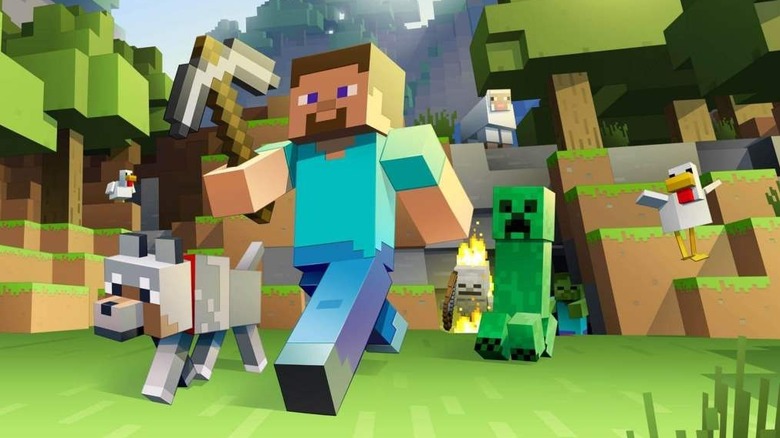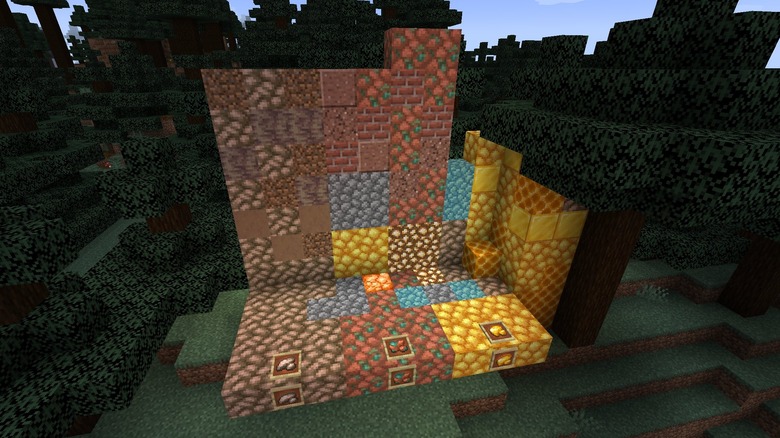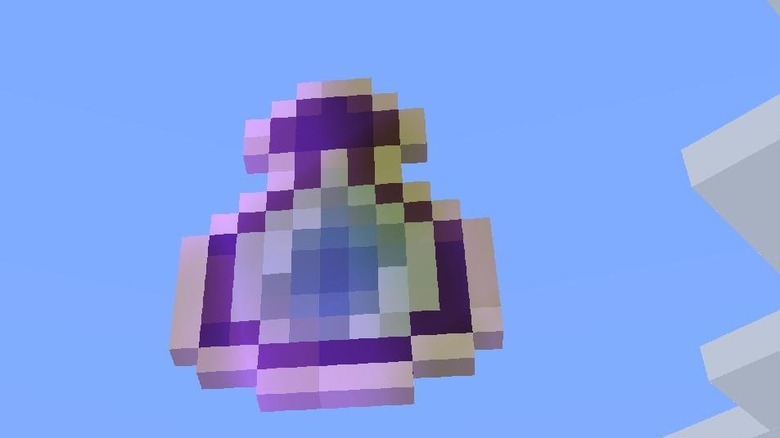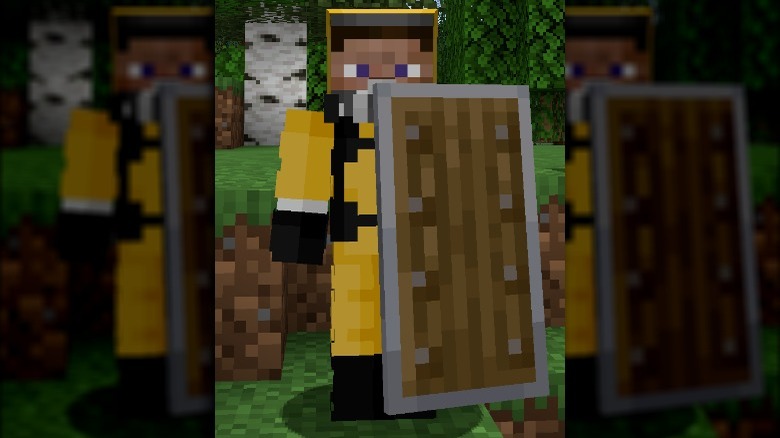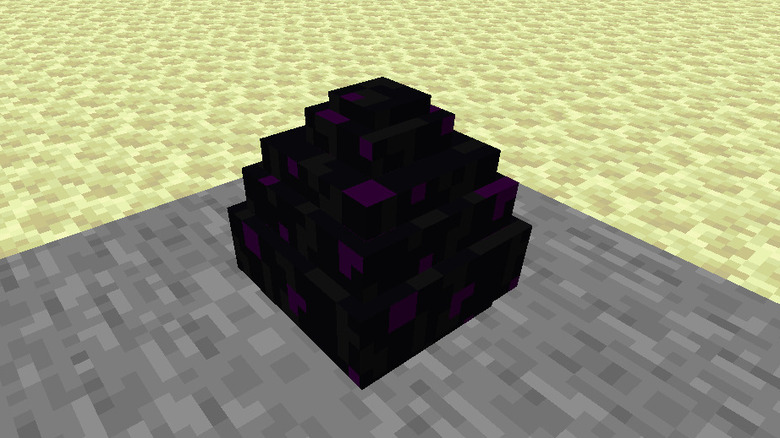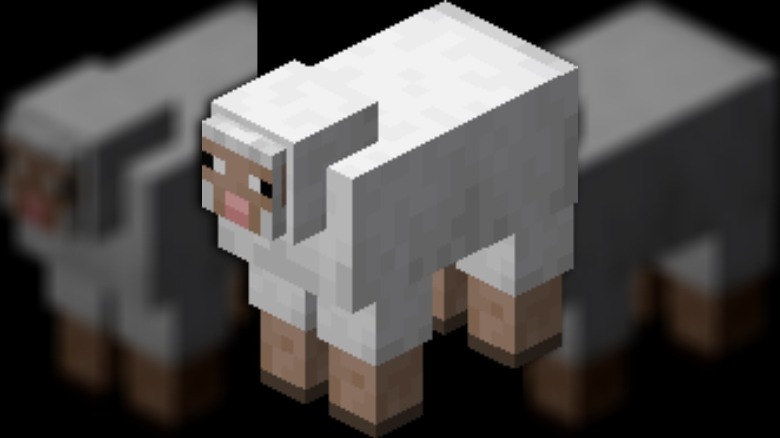Minecraft Myths That Were Never True
"Minecraft" is a game known for its vast sandbox capabilities, giving its players ultimate creative control over a vast world and all its realms. New updates — like 2021's "Cliffs and Caves" — are added all the time, granting new biomes, abilities, items, mobs, and more for players to interact with.
Because of all the fantastic adventures and abilities players have, it's hard to imagine running across a mechanic that doesn't work the way you might hope it to. Players have encountered problems like this and come up with solutions and explanations, resulting in a wide variety of myths and misconceptions about the game.
In fact, of the many "Minecraft" myths that have cycled around among players and online communities, a number of them have turned out to be simply untrue. These myths range from basic block interactions to player strategies that are meant to make gameplay a little easier, but they just don't quite work out in-game.
Grindstones don't remove curses
Grindstones are a handy way of repairing and refining your tools in "Minecraft," helping you increase a tool's durability and remove any wear and tear from regular use. They're also used to remove existing enchantments on an item, giving you a blank slate and returning the enchantment cost so that you can customize your tools as needed.
The fact that grindstones can remove enchantments leads a lot of players to believe it can remove curses, but this sadly isn't the case. As pointed out by PCGamesN, this process has very little effect on cursed items, in fact, as it doesn't even repair existing damage to a tool if there's a curse attached.
This myth that grindstones can remove curses is pretty easily disproved by simply testing it out yourself. If you're unfortunate enough to find yourself with a cursed tool, you can try putting it to a grindstone to remove the effects. Chances are, you'll remove any other enchantments you have attached to it, but the curse itself will remain intact.
You can't always negate fall damage with other damage
Fall damage is a real pain in Survival Mode, dooming players who get a little carried away building their sky bridges or who accidentally dig a hole in the ceiling of a deep chasm. As noted by TheGamer, there are plenty of ways to reduce or negate fall damage if you're prepared, but a few misleading myths have found their way into the lineup.
One such myth is the belief that taking damage right before you hit the ground will negate your fall. The fan logic here is that conveniently timed fire tick damage, attacks, or explosions would allow you to exploit your invincibility frames (a brief period of time after your character has been hurt, during which you can't sustain additional damage). This would make it so that you take only the damage from the lesser source, rather than the fall.
This particular myth is supported by a few player testimonies (and even some actual painful-looking loopholes), but it doesn't work consistently enough to be worth trying out. It's better to keep a few handy items and strategies like water buckets or well-timed ender pearls in your inventory in case you find yourself in need of a speedy, last-minute rescue. Otherwise, you're more likely to just hurt yourself even more on the way down.
Rain falling on lava doesn't make obsidian
Much like in real life, obsidian is made in "Minecraft" by cooling lava. There are a few ways of doing this in-game, all of which involve drenching an obsidian block in water somehow. Most players will either submerge the block in water or use a water bucket on it, but others have tried to get more creative, leading to the acceptance of a peculiar lava-based myth.
Simply getting the lava wet isn't enough to cut it, however — some players have believed that having an open lava pool aboveground was an effective way of farming obsidian, as the lava would cool and harden whenever it was hit with rain.
It turns out this particular myth isn't true, as in-game tests have revealed that rain and lava blocks don't interact in a way that makes this process possible. The raindrops simply fizzle and evaporate when they hit the lava blocks. Lava has to be drenched to make obsidian, which obsidian farming a somewhat tedious process of toting buckets back and forth until lava became a renewable resource as of Version 1.17.
Bees can't pollinate nether wart
Bees were an adorable addition to the "Minecraft" mob list as of the Buzzy Bees update, and brought with them a handy new pollinating mechanic. Bees can pick up pollen from flowers and berry bushes, then carry it over to certain types of plants to advance their growth stages.
Since bees tend to pollinate crops that grow in multiple stages, it was rumored that bees could be used to farm the nether wart fungus. Now, this is true if you've installed the Forestry mod, which gives you a lot more agricultural control over your world, including the ability to breed special bees that can pollinate plants like nether wart.
Unfortunately, this particular bee-havior doesn't carry over into vanilla "Minecraft." Bees will typically ignore the otherworldly fungus in favor of their favorite snacks. Unless you've modded your game, don't bother wasting your time waiting for your buzzy friends to get in gear — you're better off farming nether wart the classic way. Much like Jerry Seinfeld's "Bee Movie," this myth is a flop.
Branch mining doesn't help you find diamonds faster
Branch mining is a common practice in "Minecraft," as it's a great way to scan for resources without having to go spelunking and risk missing valuable blocks along the way. With every tunnel designed to show you all the blocks on the level, it's easy to scout out what you need and fill in the holes with the offal to mark your progress. With the whole process being so easy, it's natural to assume this is a much faster way to obtain diamonds. After all, it should be easy to spot a flash of blue among all that stone, right?
As it turns out, branch mining is no more effective than the tried-and-true process of simply dungeon-diving for loot. Finding diamonds is largely math-based, and your chances of finding a bunch of gems by meticulously checking every block on the diamond-spawning levels is lower than if you found a large, natural cave. Spelunking is simply faster, though you don't run as high a risk of getting lost. Players have seen varying results across the board, so you might as well mine in whatever way is most fun for you.
Smelting a raw iron block doesn't make an iron block
This particular myth makes a lot of sense, so it's easy to see how it came about. Now that mining iron blocks drops raw iron (via Sportskeeda), you can smelt single pieces of raw iron to make an ingot. Since nine iron ingots make an iron block, you might naturally assume that smelting an entire block of raw iron could create an iron block.
Sadly, this isn't the case. Raw iron blocks serve exclusively as a way to easily store chunks of raw iron — you can fit nine pieces of raw iron into a block, which can then stack easily in chests until you're ready to smelt it. Placing a full block of raw iron into your furnace won't do anything, meaning that you instead have to smelt each individual chunk into an ingot before combining all those ingots into a block. Yes, it's a lot of steps to achieve the same end goal.
Players hope to see a solution to this problem in future patches, but for now, the shortcut they want is nothing but a myth.
You don't have to throw Bottles o' Enchanting at your face
Potions are an effective way of gaining special effects and stat boosts in "Minecraft," and splash potions can be used to grant these same bonuses quickly or to a full group of friends. Many players know that splash potions are most effective when thrown up into the air and allowed to splash on your face — you'll get longer durations on some effects, giving you the best bonuses for the greatest amount of time.
Because of this, a lot of players assume you can do the same with Bottles o' Enchanting, special items that can spawn Experience Orbs when used. They function similarly to splash potions, meaning that they have to be thrown to activate their effects. However, they don't yield any greater benefits by being thrown directly at your face.
Player testing has revealed a pretty similar point average across the board when throwing Bottles o' Enchanting into the air, against a wall, and at the ground. This means you can throw these bottles wherever you want without worrying about lost XP.
Shields don't block splash potions
Speaking of splash potions, did you know that shields aren't actually effective at blocking them? Shields are exceptionally useful for blocking attacks, including melee attacks and many projectiles, but potions that hit shields simply evaporate and affect you anyway. If you get into a fight with a witch and they start chucking potions, your shield isn't going to be much help.
It's better to save your shield's durability for attacks that are more easily blocked. If you run into a witch, it's better to run away as best you can until you're properly equipped to take them on — just like in real life.
Many players want enchantments that can make their shields more effective, but others feel as though the buff would make them too overpowered and aggravating to use in PVP. For now, shields still can't hold up well to splash potions, so players have to find better methods of countering them.
You can only get one dragon egg per server
The dragon egg is an item that spawns after killing the Ender Dragon for the first time on your "Minecraft" server. It's easily the rarest item in the game, and as such has become a coveted trophy for many players.
Unfortunately, if you and your friends worked together on a single server to build your "Minecraft" empire and confront the Ender dragon, only one of you will get to lay claim to the prize. Some players assumed that since the Ender dragon itself can be re-summoned and defeated multiple times on a single server, the dragon egg can likewise spawn as a quest reward more than once.
This isn't the case, however — for all subsequent times you summon and take down the Ender dragon, you'll get an XP bonus (albeit a smaller one than before) and an End gateway portal. If you want to pick up another egg, you'll need to jump into a whole new server and defeat the dragon for the "first" time again.
The "jeb_" trick doesn't work on everything
Most "Minecraft" players have heard of the "jeb_" Easter egg. If you haven't tried it out for yourself yet, you can use a name tag or a renamed spawn egg to make a rainbow sheep. Simply adding the "jeb_" tag will make the sheep's wool cycle through every dye color available in the game.
The popularity of this little trick has led to a lot of speculation about what else the "jeb_" tag can do, which has in turn led to some interesting rumors. Some players wondered if using the same nametag on a goat would have a similar effect. Although a few videos have edited a rainbow effect over goats as a joke (which likely confused plenty of players who didn't know better), trying this out in-game proves that the wool sadly doesn't change from its natural color.
Muddying the waters even further is the fact that goats appeared as a texture pack for sheep before they were officially added to the game as their own mob. For a while before they became unique creatures, the name tag Easter egg actually worked. Fans have continued to bemoan the fact that legitimate "jeb_" goats don't exist.

